When most people think of caves, images are conjured of dark, dank places where bats, bugs, and other unpleasant creatures reside – places not many families would want to freely roam. Turns out, cave and cavern exploration, when done safely and properly, can be fun, adventurous, and educational for families. Kids will have a blast without even realizing they are actually learning something – perhaps the biggest perk of any family field trip.
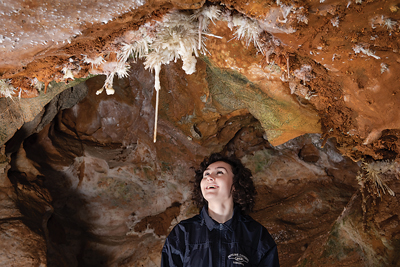
Families can experience what caves have to offer either by touring commercial caves or for all you thrill seekers, spelunking or caving on your own. While my family and I have gone on a few commercial cavern tours through the years, we haven’t been brave enough to take up spelunking (yet!).
Caves Are Everywhere
Nearly all states have at least one commercial cave that guests can explore through tours. Here in Virginia, there are actually more than 4,000 caves, although only eight of them have been developed for either commercial use or for exploration and study. Perhaps the most popular destination in Virginia, Luray Caverns is also the largest system of caverns in the East. More than 500,000 guests annually visit the attraction, which was declared a National Natural Landmark in 1974 by the National Park Service and the Department of the Interior.
John Graves, president and CEO of Luray Caverns and a member of the Virginia Cave Board, has been involved with caves in some capacity since he was a child.
“I would suspect that many individuals have no idea the importance or even the existence of caves that are under our feet,” Graves says. “I believe the most interesting item about caves is the importance they play in our water supply. They are extremely beautiful, too.”
Not only do caves provide a natural water supply, but they are also home to rare living species. Skyline Caverns in Front Royal, for example, is one of only two places in the world where a certain species of blind snail lives (the other is Germany). An unusual blind beetle dubbed the Valentine beetle was also discovered in Skyline Caverns.
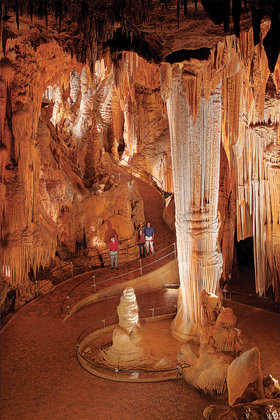
Science enthusiasts will especially appreciate visiting caves, where they hear about the karst system of topography as well as stalactite and stalagmite formations that we all learned about way back in elementary school. Many are surprised to know that these cave structures vary in size, shape, length, and sometimes even color. It can take stalactites and stalagmites 1,000 years to develop only one cubic inch, another wonder. Geology and chemistry come into play throughout your entire cave visit.
“It is a learning experience, giving you a chance to discuss rocks, minerals, caves, karst, or geology in general with your friends and family,” says Jamie Figgins with Skyline Caverns. “We pay so much attention to what is above ground that we sometimes miss the beauty of what is underground. These caverns are not man-made. They were formed by water just rushing through for years and years in complete darkness.”
It’s a Natural Learning Experience
On our recent tour of Skyline Caverns, my family and I were in awe of all the anthodites, which are mineral
deposits composed of long needle-like crystals in clusters that resemble sea urchins. Only three caverns across the globe feature anthodites; the other two are in Mexico and France. Skyline Caverns also features three flowing streams that are viewable from inside the caverns, a rarity for Virginia caverns.
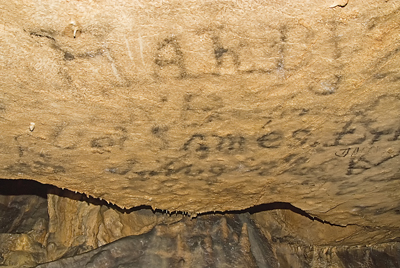
“I have heard the expression, ‘When you have seen one cave, you have seen them all,’ but that could not be further from the truth,” says Figgins. “The history, geology, and formation types are all vastly different. Even the types of tours can vary. Numerous caverns are flooded caves, so their tours are by boat.”
My family and I have checked out a handful of caverns across the country and have been to Luray Caverns multiple times to admire its famous Great Stalacpipe Organ. My two kids (ages sixteen and fourteen) have also been on numerous cavern tours during school field trips, but they never tire of visiting caves. My son loves learning how our world works and taking in all of the planet’s natural beauty.
In addition to science, families also learn about history by touring caves.
“Gap Cave is steeped in rich history,” shares Carol Borneman, supervisory manager of Cumberland Gap National Historical Park, where Gap Cave is located.
Though Thomas Jefferson never visited Gap Cave, he does refer to it in his Notes on the State of Virginia. Meanwhile, soldiers from both the Union and the Confederacy explored Gap Cave during the Civil War.
“Many of them wrote their names on the cave ceiling or wall using the flames from candles,” Borneman says. “Presently, almost 300 soldiers’ names have been recorded. As cave environments change so little over the years, visitors can see the formations which were viewed by these soldiers.”
What to Expect When You Tour
In addition to being educational, cavern tours are a wonderful family-friendly choice that will connect you to the environment. Nothing compares to visiting a place in person instead of looking at pictures of it in a book or on a website, or watching a video about it on YouTube.
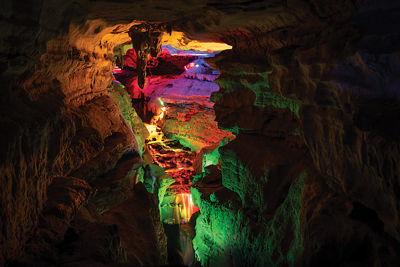
According to Figgins with Skyline Caverns, family tours are unique, especially when compared to other modern attractions and experiences. “Sure, you can have all the flashy and cutting-edge technologically-based attractions, but what beats standing inside a living, breathing cave that formed thousands of millions of years ago?” asks Figgins. “You feel the coldness of the air, you hear the water dripping down, and you see the formations with your own eyes instead of in a textbook.”
That natural element makes a cavern tour a different experience in other ways, too. When considering a tour, families need to keep in mind that it’s colder underground (yes, even in the summer!), so bring a jacket. Caves also involve a lot of walking, with tours usually lasting an hour or more, so wear suitable footwear. Caves are also often steep with narrow passageways, so strollers and wheelchairs are not recommended. Restrooms are also not available inside the caves and caverns, so be sure to plan accordingly. And you can take as many pictures as you like, so bring a camera along or have your phone setting ready for low light.
What About Spelunking?
Prefer to head out to explore a cavern or cave on your own? You will be a spelunker.
“Spelunking is a popular activity throughout our Virginia cave systems,” says Graves. “There are many spelunking opportunities on privately owned property. I strongly recommend joining one of the many spelunking groups because experience, expertise, and organized caving is paramount in a safe caving experience. Spelunking is a potentially high-risk sport that requires many skill levels.”
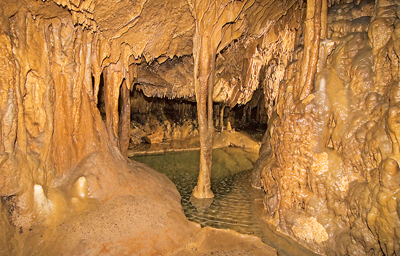
Organizations such as the National Speleological Society (caves.org) are a good place to start. Kids as young as eight can begin spelunking in a supervised environment with experienced cavers, depending on maturity, comfort level, and physical fitness. Spelunking can be challenging and involve specialized equipment, including special clothing, footwear, lighted headwear, and rappelling equipment.
“Caving is a good workout,” says Mark Hodge, an experienced caver and a member of the Virginia Cave Board as well as a member of the Butler Cave Conservation Society in Virginia, the oldest cave conservancy in the country.
“It is definitely a different hobby than what people normally do,” Hodge says. “It is challenging, but it is also a fascinating thing to do. Caves are just crazy places. You see things you don’t normally see. People visit just to see the nature of it all, just for the wonder of it.”
Like Graves, Hodge highly recommends reaching out to a group of experienced cavers if you are considering
spelunking by yourself or with the family. Groups through the National Speleological Society typically meet about once a month.
“Make sure you have someone knowledgeable to go with you,” Hodge stresses. “You can get yourself in a real fix real quick. It’s not like going to Disneyland. You can get yourself into trouble if you don’t know what you are doing.”
The potential danger shouldn’t discourage families from giving it a try. There are many caves in the region
that provide easy access for beginners.
When you are considering your next family field trip, think about making fun family memories underground – where it’s cool even during the summer. Whether you prefer to visit a cave or cavern through a guided tour or explore on your own, you and your brood will learn something new while experiencing nature
in the process.
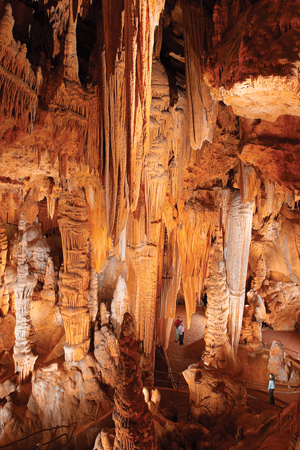 If You Go!
If You Go!
Whether you want to explore here in Virginia or beyond, here’s a list of commercial cavern tours to get you started on your next adventure. Some cavern tours currently require face coverings. Visit cavern websites for the latest COVID-19 safety protocols, restrictions, and potential schedule changes.
In Virginia
Dixie Caverns, Salem
With its adjacent campground, Dixie Caverns is perfect for families who enjoy the outdoors. The Gift Shop and Antique Store here make for fun family browsing.
Nearby attractions: With several antique shops, local breweries, and Longwood Park for the kids, Salem is a delightful above-ground destination.
dixiecaverns.com
Gap Cave, Ewing
Gap Cave is located within Cumberland Gap National Historical Park near the Tennessee border. Families can camp and hike or horseback ride the more than eighty miles of trails within the park.
Nearby attractions: Nature lovers, especially bird watchers, can explore either within Cumberland Gap National Historical Park or at nearby Wilderness Road State Park and Historic Martin’s Station or Burke’s Garden.
nps.gov
Grand Caverns, Grottoes
Grand Caverns was ranked second in the country by Parade for its features including its overall beauty. Don’t miss the Rainbow Room that illuminates the caverns with colored lights.
Nearby attractions: The park at Grand Caverns has plenty of other amenities to keep families entertained, including scenic trails for hiking and biking, a playground, a seasonal pool, and a year-round mini-golf course. Thomas Jefferson’s Monticello is about an hour away.
grandcaverns.com
Luray Caverns, Luray
One of the most well-known systems of caverns in the United States, Luray Caverns has numerous chambers and is home to the Great Stalacpipe Organ, with organ pipes that are made from stalactite formations.
Nearby attractions: Take the little ones to see the animals at Luray Zoo or hike up Stony Man Mountain in Shenandoah National Park.
luraycaverns.com
Natural Bridge Caverns, Natural Bridge
These caverns are the deepest on the East Coast at thirty-four stories underground. A natural highlight of Natural Bridge Caverns is the Colossal Dome Room, one of the largest dome-shaped masses of flowstone in the East.
Nearby attractions: Families should also visit Natural Bridge State Park, a wonder all its own. Virginia Safari Park, a drive-through zoo, is only ten minutes from the park.
naturalbridgeva.com
Shenandoah Caverns, Quicksburg
Shenandoah Caverns is the only cavern system in the state with an elevator that takes you underground to explore its seventeen rooms and passageways. Shenandoah Caverns also has an illuminated underground lake called Rainbow Lake, as well as its famous Breakfast Bacon formations, which were once featured in National Geographic.
Nearby attractions: Check out a variety of parade floats at American Celebration on Parade, open Memorial Day through Labor Day.
shenandoahcaverns.com
Skyline Caverns, Front Royal
Skyline Caverns is famous for its anthodites. It remains a mystery how these rare, beautiful cave formations, dubbed Orchids of the Mineral Kingdom, are actually formed.
Nearby attractions: Front Royal has a quaint downtown area with shops and restaurants and easy access to Skyline Drive in Shenandoah National Park. The town
is also not that far from Washington, DC.
skylinecaverns.com
Beyond Virginia
Mammoth Cave National Park, Kentucky
This park includes eighty-five trails above ground and multiple cavern tours below. Mammoth Cave is part of the world’s longest known cave system. In addition to touring the caverns, guests can hike, bike, horseback ride, canoe, kayak, and camp at Mammoth Cave National Park. Other lodging is also available, making this a family vacation destination all on its own.
nps.gov
Howe Caverns, New York
Howe Caverns, which recently reopened in May, offers a variety of tours. The traditional 90-minute tour includes a boat ride. Howe Caverns also has an escape room attraction. We visited Howe Caverns on a trip to Cooperstown, NY, home of the Baseball Hall of Fame, which is an hour from the caverns.
howescaverns.com
Indian Echo Caverns, Pennsylvania
In addition to caverns, amenities at Indian Echo Caverns include gem mill mining, a gift shop, and a playground with a petting zoo. Plan to visit Indian Echo Caverns during a family trip to Hershey Park, which is only ten minutes away.
indianechocaverns.com
Penn’s Cave, Pennsylvania
Penn’s Cave is the country’s only all-water cavern,
with tours conducted entirely by boat. Tours last about forty-five minutes. There is also a wildlife park on-site. Penn’s Cave is in Central Pennsylvania, surrounded
by state parks with access to hiking, fishing, and swimming. It’s also a half-hour drive to the main campus of Penn State, which has an arboretum with
a children’s garden and family activities.
pennscave.com
Photos: Mark Delsasso (Luray Caverns)





